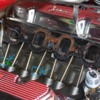I have the intake manifold and I have a couple questions please. At the attached picture with the 2 arrows the push rod "guides" (for lack of a better term) are about 1/4 inch higher than all of the others which set flush with the top of the block. Do I need to worry about this? Is there a fix to this?
Second question, what do I need to do to get all of the crap off of the surfaces where they mate up to the manifold?
thanks
Gary #06984
Attachments
Original Post



